After the decline of the Chavín theocratic state and the end of its cultural hegemony in the Andean area, different regional cultures emerged; New types of state were organized with characteristics that were no longer pan-Andean but regional and theocratic-militaristic. This historical period that covers approximately from the first century A.D. until the 8th century AD. It is called First Development and Regional Splendor where cultures such as:Nazca, Mochica, Huarpa, etc. stood out. Other researchers also call this stage:• Early Intermediate, because it is historically located between Chavín and Wari (Pan-Andean States• Epoch of the Master Craftsmen, for the great development of ceramics, metallurgy, sculpture and textiles. • First heyday of the theocratic-militarist states, for its regional expansionism and the predominance of a priestly and military caste. But, it should be clarified that this period falls within the Expansive Classism, in general.
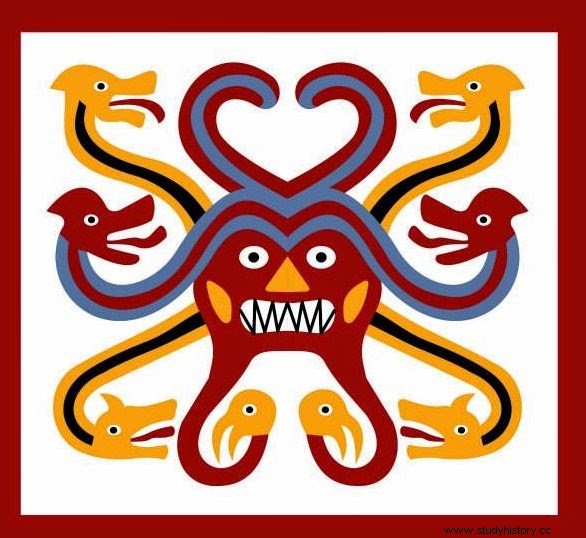 MOCHIC ICONOGRAPHY MOCHE SOCIETY
MOCHIC ICONOGRAPHY MOCHE SOCIETY (100dc-800dc) LOCATION
The Mochica culture developed in the valleys of the northern coast of present-day Peru; in fertile valleys formed by the rivers Ñepeña, Huarmey (Ancash), Moche, Chicama (La Libertad), La Leche, Zaña (Lambayeque). These areas were productively occupied by peasant families, who took economic advantage, converting the set of valleys into cultivated fields; To do this, they even overcame an obstacle:the lack of water, since the garúa, a drizzle of tiny drops, does not provide enough liquid for agricultural activity. They also used the resources that the immense sea offered them. This culture was discovered by the German archaeologist Max Uhle, who called it proto Chimú. Later Julio C. Tello called it Mochica, based on the Muchik language spoken by the ancient inhabitants of the north coast of Peru.
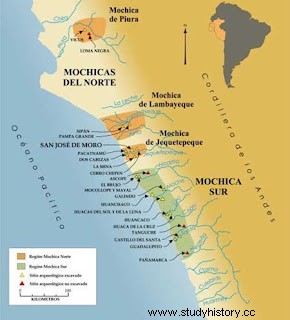 Location map of the Moche Society
Location map of the Moche Society ANTIQUE They reached their apogee in the first centuries of our era approximately from the 1st century to the 6th century AD. Of course they didn't appear out of nowhere; The Mochicas arose from the agricultural and artisanal ayllus of Virú, after the dismantling of Chavin, as well as from Cupisnique and Salinar, former village centers of agricultural and artisanal work. At the beginning of our era they came to structure a theocratic-military State. Centuries later, the Moche State entered into internal contradictions and wars against southern societies, that is, with the Wari Empire, leaving several centers that evidence their work abandoned in the 7th century; but the peasants, goldsmiths and artisans became tributaries of the Wari.
ORIGIN It is called the Mochica culture because of the name of the language, the muchik, which its inhabitants spoke. According to Julio C Tello, it was the Muchick civilization that gave rise to it. The elements of the Cupisnique (“Chavín Costeño”), Salinar, Vicús and Virú cultures merged to form the great Moche culture in its early days. After this long process, it appeared as an autonomous regional synthesis, with greater technological and ideological contributions than any other north-coastal and Andean culture.ECONOMY:
The Mochica practiced different economic activities to complement their diet, including duplicating efforts to transform the arid soils into highly productive lands. In agriculture, they developed their best signs of ingenuity and effort, building aqueducts such as Ascope and the Canal de la Cumbre (both in Chicama), with the aim of channeling the waters of the rivers that flow from the Andes and overflow in the months Of summer. They cultivated corn, beans, peanuts, pineapples, plums, etc. They planted them on land fertilized with guano from the islands and camelid manure. The Mochica fished in the sea using small canoes, currently called caballitos de totora; They caught cold-water and warm-water fish with hooks, nets, and harpoons. They captured sea lions, beating them with big clubs. Fishing was a complementary economic activity to agriculture. The trade, carried out with neighboring ethnic groups of the Moche State, was done through the exchange (directed by the authorities), of products with the Quechua and jungle regions. This is evidenced in its goldsmithing of precious stones, such as turquoise, and in the use of metals such as gold and silver, which are typical of the northern jungle. “The Mochicas were familiar with metallurgy and worked with gold, silver, copper and tested various alloys between them. They were experts in gilding over fire and cold and they also welded metal parts with magnificent results so that if it is not entirely possible to make an accurate inventory of the cultural heritage of the Chimú, apart from that received from the Mochicas, as well as that they received from the vicus, the existence of a legacy in metallurgy cannot be denied” (Illescas – 1990). “The peoples of the different cultural horizons of Peru worked with gold, silver and copper, but their useful curiosity went further and led them to produce Tumbaga and other alloys in search of harder and more resistant bodies for a work envisioned by its mind. However, the production of bronze among the peoples of the north coast is scarce, although there are examples of interesting works made with this alloy. They made tools of remarkable hardness by tempering the copper with a hammer or by obtaining this property in the same Philonean deposits, a material known by the name of champi (Illescas - 1990). “The Mochicas tempered, welded and gilded the copper using special techniques, extracted the copper with wooden candles with a copper point and crushed it in the Miray (stone mill). The smelting of the ore was done in a furnace called the huayra. All this shows us the great progress we have achieved in metallurgy in ancient Peru. Despite the fact that the production of copper in ancient Peru covered 85% of the utensils used by the people, with a millenary tradition in the treatment and use of this metal, the information in this regard is very scarce (Illescas - 1990).
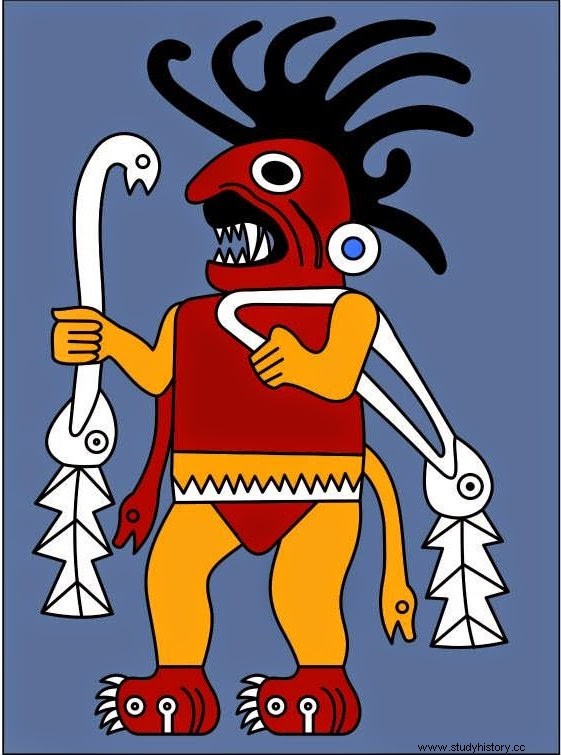 MOCHE FISHERMAN SOCIAL ORGANIZATION: During the decomposition of the Chavín theocracy, militarized sectors emerged that took political control in different regions. In the Moche valley a group of warriors emerged who displaced the priests from the leadership of the State. In this way, the Mochica warriors and priests formed a new ruling class, owner of the means of production (land, livestock, labor), who, in order to maintain their privileges, used generalized repression through the mechanisms of power (army, sanctions, religion) and constituted a militaristic-theocratic state. The working class – peasants, artisans and fishermen – formed the base of society, but, as a subjugated sector, they had to pay taxes to the State, with their labor force, making pottery, cultivating fields for the leaders, building sanctuaries for the priests. , etc. It was a classist, aristocratic and warrior society. The various social classes that existed had very marked differences. At the top of the social pyramid were the military, who were the power group or ruling class; the Cie Quich, was the ruler of a Confederation of valleys; while the alaec were the chiefs of each of the valleys, who were subordinate to the Cie Quich. The priests were also part of the power group, they were in charge of the complicated religious ceremonies and human sacrifices.
MOCHE FISHERMAN SOCIAL ORGANIZATION: During the decomposition of the Chavín theocracy, militarized sectors emerged that took political control in different regions. In the Moche valley a group of warriors emerged who displaced the priests from the leadership of the State. In this way, the Mochica warriors and priests formed a new ruling class, owner of the means of production (land, livestock, labor), who, in order to maintain their privileges, used generalized repression through the mechanisms of power (army, sanctions, religion) and constituted a militaristic-theocratic state. The working class – peasants, artisans and fishermen – formed the base of society, but, as a subjugated sector, they had to pay taxes to the State, with their labor force, making pottery, cultivating fields for the leaders, building sanctuaries for the priests. , etc. It was a classist, aristocratic and warrior society. The various social classes that existed had very marked differences. At the top of the social pyramid were the military, who were the power group or ruling class; the Cie Quich, was the ruler of a Confederation of valleys; while the alaec were the chiefs of each of the valleys, who were subordinate to the Cie Quich. The priests were also part of the power group, they were in charge of the complicated religious ceremonies and human sacrifices.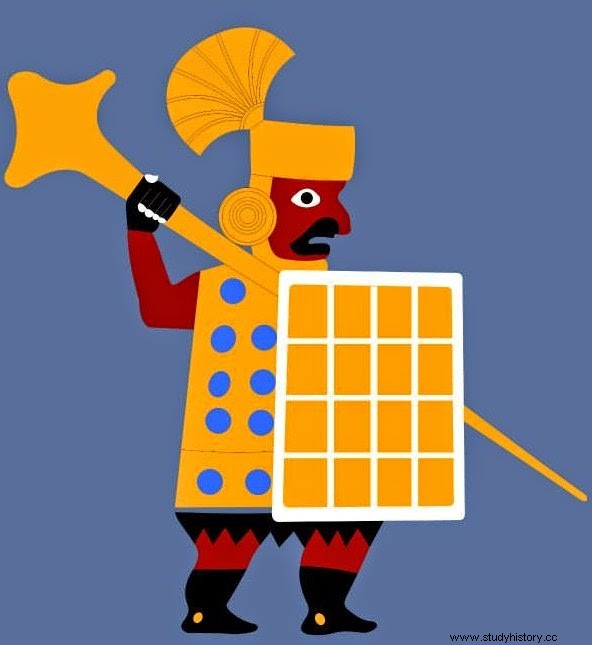 MOCHICA WARRIOR
MOCHICA WARRIOR 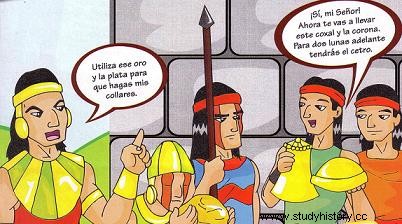
POLITICAL ORGANIZATION: Traditionally it was thought that the Mochicas had constituted a single political organization that spanned from Piura to Chimbote. Current information allows dismissing such fact; because there were different organizations that, throughout 700 years, interacted with each other; sometimes joining; and others through conquest. Based on the available vestiges, especially in the ceramic style similarities, two large regions can be noted:the northern Mochica territory, which included the valleys of Piura, Lambayeque and Jequetepeque; the central Mochica territory, which includes the valleys of Chicama, Moche and Virú, Chao, and finally, Santa and Nepeña in the south. The Mochicas did not organize a unified state. In the different valleys they occupied, they organized small independent states led by military men - priests, who were in charge of planning public works, controlling surplus production and organizing religious ceremonies. At a certain point in their historical development, the states established political-military alliances, forming a Confederation of Valleys. This was directed by the Cie Quich, a military ruler-priest, at the same time that he directed the wars that were undertaken to achieve territorial expansion.
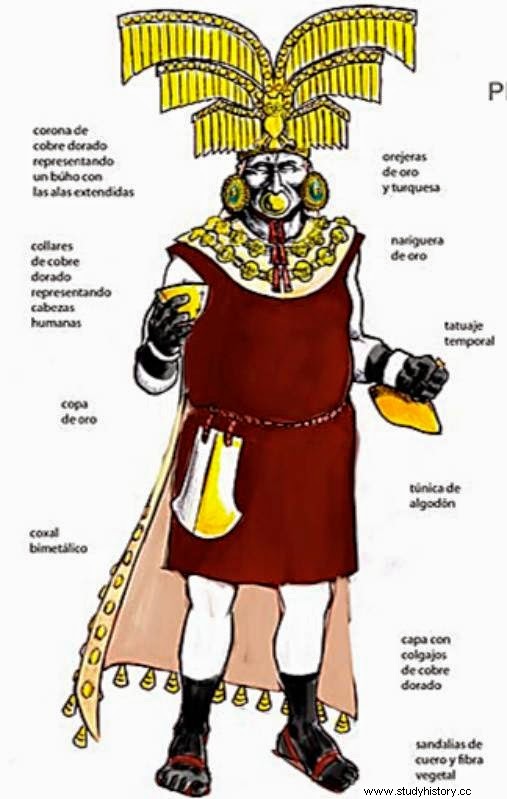 Moche Priest
Moche Priest 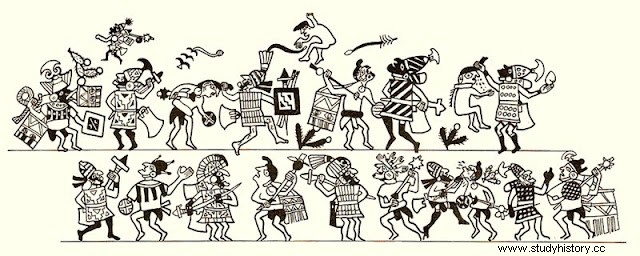 MOCHE ICONOGRAPHY CULTURAL MANIFESTATIONS: CERAMIC:
MOCHE ICONOGRAPHY CULTURAL MANIFESTATIONS: CERAMIC: They used molds to make ceramics in series, in which they represented fruits, animals and human beings. They captured, with great skill, activities of daily life, such as fishing, rites, artists, carriers of royal litters; They also represented genital diseases and sexual acts. In its beginnings they preferred the black color, but they derived to red-brown combined with white:from monochrome they passed to bichrome. The stirrup neck. Ceramic work was part of the work that the popular sectors had to do for the benefit of the privileged classes. The representative Mochica ceramics are globular in shape with a stirrup handle. They used molds to make the pottery, and they used two colors:cream and Indian red, which is why it is said to be bichrome pottery.Ø Pictographic :Scenes from his daily life
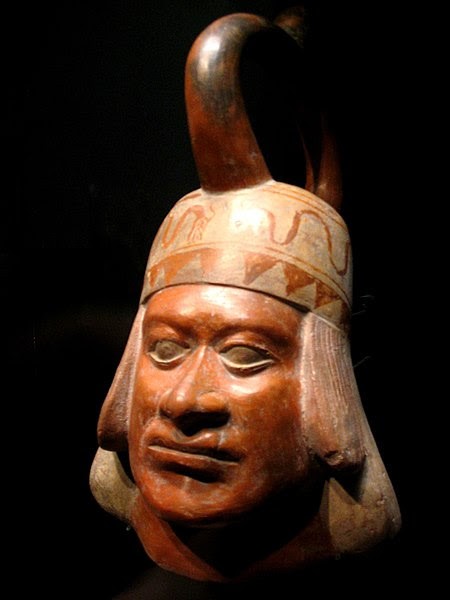 HUACO PORTRAIT
HUACO PORTRAIT They made two types of pottery:
Mochica Phase I
PICTORIAL OR ICONOGRAPHIC CERAMICS:
In these ceramics through drawings they represented scenes of their daily life, hunting, combats, rituals and divinities. They elaborated them in such a detailed way that they look like illustrated dictionaries.
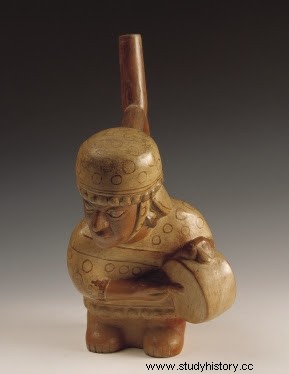 Mochica musician with drum.
Mochica musician with drum. 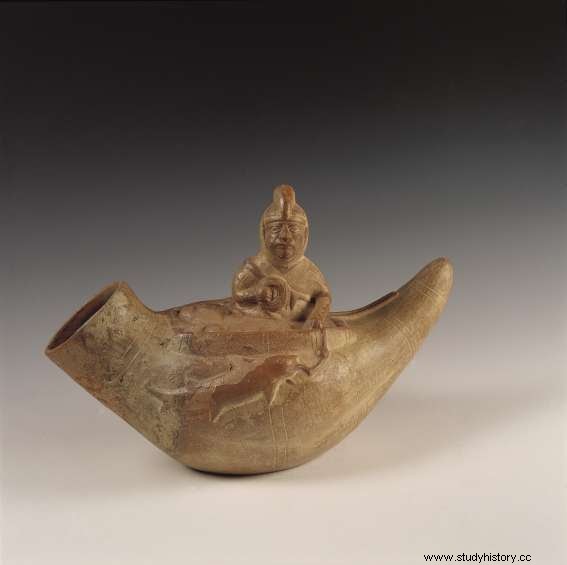 Mochica fisherman in a boat called “caballito de totora”.
Mochica fisherman in a boat called “caballito de totora”.  Mochica representation of the tuber called potato. SCULPTURAL CERAMICS:
Mochica representation of the tuber called potato. SCULPTURAL CERAMICS: They made the best sculptural ceramics from Peru and America. It was three-dimensional. They stand out:the huacos portraits, which represent human faces in different states of mind; the erotic huacos, which represent sexual scenes of human beings and animals, possibly worshiping fertility or representing scenes performed in ceremonial contexts; pathological huacos, where they represented various diseases such as uta, goiter, among others.
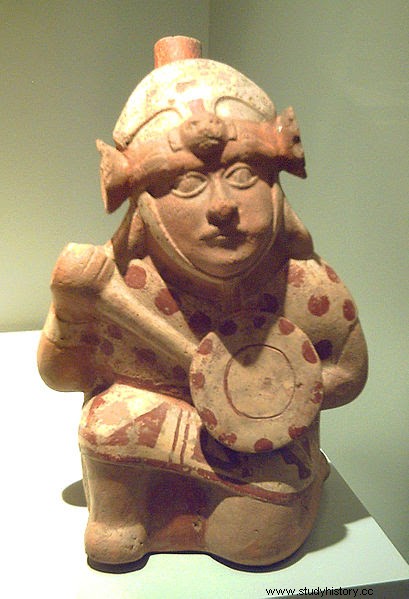 Kneeling Mochica warrior with weapons.
Kneeling Mochica warrior with weapons. 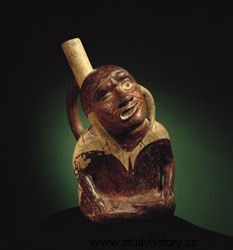 Sculptural ceramics. Male with facial paralysis.
Sculptural ceramics. Male with facial paralysis. 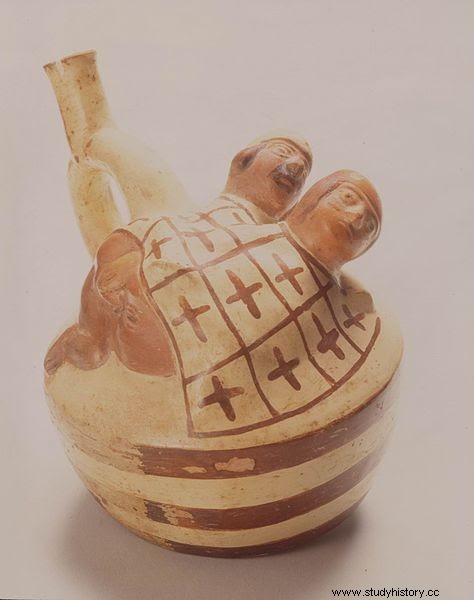 Mochica erotic art.
Mochica erotic art.  Huaco portrait. Male smiling.
Huaco portrait. Male smiling. continued on next page.....
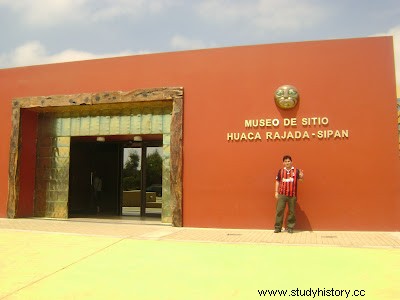 Visit to the "Huaca Rajada - Sipan" Site Museum
Visit to the "Huaca Rajada - Sipan" Site Museum 